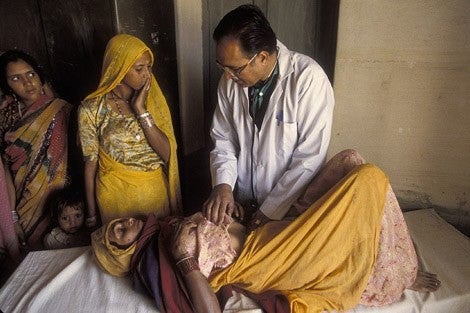August 7, 2014 — Today more people than ever have health insurance. In the U.S., millions have signed up for coverage since the 2008 passage of the Affordable Care Act. Globally, there’s a high level of interest in establishing universal health coverage in countries without it. It’s expected that the UN’s Sustainable Development Goals—a set of new worldwide goals for 2015 and beyond, currently under discussion—will emphasize the importance of such coverage.
But health policy expert [[Ashish Jha]] cautions against focusing only on numbers of insured. Instead, he asks: Does health insurance actually give people good access to health care? If they do have access, are they getting effective—and safe—care?
Jha, professor of health policy and management at Harvard School of Public Health (HSPH), offered troubling statistics on health care quality around the world—as well as his prescription for improving it—at a July 29, 2014 Hot Topics lecture at the School.
“Most people think if you give people access to health care, they should have better outcomes,” Jha told the capacity crowd in Kresge G-2. “But health care alone doesn’t improve people’s health. And the missing link between health care and health is quality.”
Most people define good health care as care that’s safe, effective, and patient-centered. But all too often health care doesn’t meet those standards, said Jha.
‘The most dangerous places in the U.S.’
One problem affecting health care quality is hospital safety. Jha said that Medicare data suggests that older Americans have a roughly one in four chance of being hurt during a hospital stay. “That is an astronomically high rate,” he said. “There is nothing you do in your life that has a 25% chance of hurting you. Hospitals are by far the most dangerous places in the U.S.”
Worldwide, for all ages, Jha said the chances of being hurt in a hospital are roughly 10%. Possible dangers from hospital stays include things like infections, medication errors, falls, and blood clots.
“Our best estimate from a couple of years ago is that there are about 43 million injuries a year in hospitals around the world, leading to about 23 million healthy years of life lost,” said Jha. Two-thirds of medical errors occur in low- and middle-income countries. Hospital injuries are “probably one of the top 10 causes of suffering and death around the world,” he said.
Ineffective care rampant
Another problem is health care ineffectiveness, said Jha. He cited a 2003 study that found that Americans were receiving effective care for well-understood health problems only about 55% of the time. That percentage was based on interviews of a random sample of adults in 12 communities across the U.S. about their health care experiences and reviews of their medical records.
Effective health care is also lacking in other countries. Jha cited research that found that people in rural and urban sections of India with common ailments have a 55%–70% chance of getting the wrong treatment from their doctors. Researchers got these results by monitoring the experience of actors who’d been trained to fake symptoms of common conditions such as angina, asthma, and dysentery. Similar results have been uncovered in other countries.
Jha cited other disturbing findings: a study of five low-income countries found that doctors do patient histories and physical exams properly only 41% of the time. Other studies from low- and middle- income countries suggest that patients there only infrequently get the right diagnosis from their doctors and, more often than not, fail to receive the right treatments.
Issues of culture, complexity
Sometimes health care quality issues stem from organizational culture. For instance, Jha said that doctors in public clinics in India typically spend just one minute with each patient and take lengthy breaks, whereas the same doctors working in private clinics spend more time with patients.
In the U.S., the complex nature of health care can affect quality. Nowadays, “care is far more effective, and far more dangerous,” Jha said. For example, in an emergency room, a patient with heart attack symptoms could receive a dozen interventions and come into contact with a dozen health care workers. “The sheer amount of information that needs to flow, all of those things interacting with each other—this is not something that human brains can manage,” said Jha. “We have made none of the investments necessary to manage the kind of complexity we have.”
Good metrics, good data
Accurately measuring health care quality is key to improving it, Jha said. It’s important to use good metrics—such as patient satisfaction, mortality rates, and infection rates at hospitals—and good data, such as billing data from doctors and hospitals. Such data is readily available in the U.S. and will become increasingly available in other countries as universal health coverage spreads.
The bottom line? “Universal health care is critical to improving the world’s health,” said Jha. “But quality needs to be on the agenda. If we only give people access to the same relatively lousy heath care that we have today, we’re not going to make a big impact on people’s health.”
photo: Curt Carnemark/The World Bank
